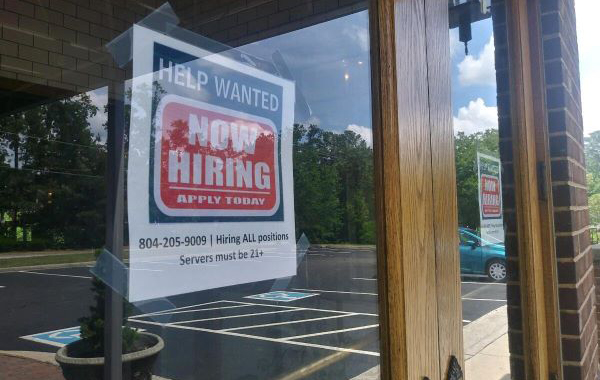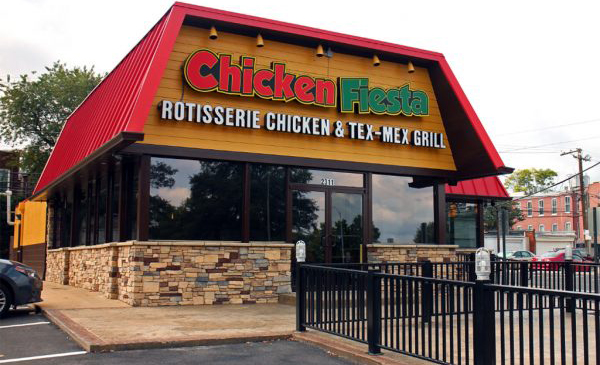
A help wanted sign is taped to the front door of Tarrant’s West. Local restaurants have raised wages, increased benefits and launched other efforts to attract workers. (Jack Jacobs photo)
It was when employees sought time off in the spring, as more customers began to trickle back into her restaurants, that the beginnings of the larger labor shortage Liz Kincaid now grapples with first came into view.
“We realized ‘Oh, we don’t really have enough coverage for people to take the time off that they want to take off,’” said Kincaid, COO of RVA Hospitality, the restaurant group behind Tarrant’s Cafe, Tarrant’s West, Max’s on Broad and Bar Solita.
The group started to hunt for more help, figuring the continued reopening of the economy would lead more diners and workers to their doors. The hungry patrons came, but the expected surge of employment applications didn’t.
So they raised their wages and began to advertise the higher pay. Still, the wave of workers never came.
“We thought with unemployment so high, we expected a flood of applications and we didn’t get any,” Kincaid said. “We were one person away from not being able to serve Friday night dinner, one person gets sick or one person goes out of town and we can’t do it.”
A little over a year since the effects of the pandemic were first felt in the U.S., Richmond-area restaurants find themselves largely cleared to operate as they did pre-pandemic. Gov. Ralph Northam ended restrictions on capacity and distancing at restaurants and other settings in late May.
But local operators say they struggle to capitalize on that opportunity because they can’t find and keep employees. Some blamed the challenge on would-be workers’ apprehension about becoming infected with COVID-19, former industry workers going into other sectors, or government unemployment benefits that are more appealing than the compensation they offer.
To try to combat what some say is the most challenging aftershock of the coronavirus pandemic, many restaurant groups have begun to roll out bigger benefits packages, pay bumps, referral bonuses and other enticements.
“We survived the pandemic, but the biggest crisis we’ve faced so far is the hiring crisis,” Kincaid said.
More benefits, more cash
For Buz Grossberg, owner of Buz and Ned’s Real Barbecue, larger benefits packages alongside wage hikes is the early blueprint to entice new hires.
Grossberg said he plans to roll out life insurance and has reintroduced short- and long-term disability to attract employees, in addition to existing benefits. His two restaurants also started to offer a $1,000 bonus for employees who stick around for a year.
While he expect those offerings to lead to a 25-35 percent spike in personnel costs, Grossberg said he has little choice.
Neither Buz and Ned’s location (there’s one near Scott’s Addition and another in Henrico County) has been open for regular dine-in service since March 2020. The restaurants have limped along with catering, takeout and delivery service.
“We haven’t (fully) reopened because we can’t find staff. We’re going on a year and a half being a restaurant without a dining room,” Grossberg said in early June, adding that he only has about three-quarters of his pre-pandemic staff in place.
Grossberg plans to reopen both locations later this month, but only offer dine-in service in a limited space centered on the restaurants’ bars. The plan is to gradually reopen larger sections of the restaurants over time as more employees are hired.
Local chain Chicken Fiesta kicked its starting pay up to $12 an hour late last year to get ahead of the hiring problem. District Manager Karen Ortiz said the company has been able to recoup some of the 20 to 25 employees cut from its pre-pandemic workforce of 120 people by early June, a development she credited to the higher wages.
However, it has remained a challenge to find enough people to get back to full strength and also put into action plans to open new locations. The chain has five locations in the Richmond area.
“At that point, you can’t find employees to work the locations you already have,” she said.

The Chicken Fiesta at 2311 W. Broad St. The local chain increased hourly wages but still hasn’t been able to find enough employees. (BizSense file)
RVA Hospitality also has had to limit some of its operations because of the labor shortage. Kincaid said its pre-pandemic employee count of 300 remained cut in half as of early June.
“We’re not able to staff our restaurants for the current level of business, much less the level of business that wants to come,” Kincaid said. “We need about 100 people companywide to get back to the level of business we’d like to be at.”
In addition to bumping up its starting hourly wage for cooks to $14 to $15, the company has rolled out short- and long-term disability for salaried employees.
Further casting its net, Kincaid said the company in recent weeks has started to use the Virginia Department for Aging and Rehabilitative Services’ job placement services. The programs match employers with people coming out of prison, or disabled people or those re-entering the workforce after an extended period.
Kincaid said the state program had helped them find at least one new employee by early June, though she hopes for more fresh faces to come out of the new pipeline.
“That’s the only one that I know of, but that’s one more than we had,” she said.
More with less
In mid-April, Kevin Healy’s HOUSEpitality Family restaurant group, which operates The Boathouse, Casa Del Barco and Island Shrimp Co., rolled out a new employee referral program.
Employees who refer new hires get $1 per every hour the new hire works up to $1,000. The payment perk takes effect with the new hire’s first shift. In late May, there were 18 referring employees who were reaping the benefits of the program.
That referral program comes a year after the restaurant group reworked its employees’ wages. It added a 20 percent service charge to diners’ orders in lieu of tipping, and what tips are given are split across each restaurant’s workforce.
Those efforts boost dishwashers’ pay to around $20 an hour. Servers and bartenders make about $25 an hour.
Healy said in late May his restaurants had hired 220 people since March of this year, though not all of those people have stayed on. That brought its headcount to 420 employees, which was about 60 bodies short of a full complement.
Healy framed the new wage system as a means to cast the hiring net into retail and other non-hospitality sectors rather than a means to lock down more experienced restaurant talent that may believe they do better in a restaurant with a more traditional tips system.
The state’s minimum wage was increased to $9.50 on May 1.
With fewer workers, Healy, like many of his peers, said he’s also begun to rely on automation and touchless technology to reconfigure workflows.
The introduction of QR codes for menus and contactless ordering and payment lessens the need for as many servers. And those servers that continue to work at the restaurants are able to focus more on being hosts and less on order-taking, and also oversee more tables at a time, Healy said.
He said there are about 50 percent fewer servers these days, but there are now more food runners and busboys. He said the result is workforce that is 10 percent smaller than it was pre-pandemic but that can handle the same workload.
Healy said customers have mixed opinions on the restaurants’ new system. While there are some diners who have taken to the new way of doing things, others can best be described as tolerant or openly frustrated with it.
“There are people who come in and don’t like the touchless service, and for those people we try to pivot quickly and we can take their order. But we try to educate them,” he said.
Starting from scratch
Healy might make a believer out of Garland Taylor, who is working to open Sloop John B, a Caribbean-inspired taco restaurant at Regency mall in the West End.
Taylor said in early June he is weighing whether to introduce a similar wage system to what Healy is using as he begins to ramp up hiring for the new concept.
“There’s uncertainty in the market for the operator and the worker, and I think this program takes a little bit of that and adds a level of structure and through structure adds a little more surety assurance,” Taylor said.
Taylor has started to fill out the management team for Sloop John B, and has hired a general manager he declined to name. The general manager has worked in the Richmond area for more than a decade, and Taylor is banking on name recognition to be a source of employees.
“People follow people that they know, so I think that will help us fill out the team,” he said.
Taylor, who also owns Twin Hickory Tavern, said seasonal summer workers have helped fill in the gaps at the Glen Allen restaurant, but expected he will feel the hiring pinch more acutely once schools are back in session.
Pre-COVID, he had about 40 employees, and in early June had a headcount of around 30 people. Garland said he doesn’t plan to introduce a Healy-style wage system at Twin Hickory.
Further illustrating the hiring difficulties, Taylor had to go out of state to find a general manager for Twin Hickory — something he’s never had to do before.
“I couldn’t find anyone local. I actually brought in a manager who decided he was tired of the cold in Chicago,” he said.
Retaining employees
For some operators, getting new hires onboard is one thing and keeping them is another. To fix the retention problem, some restaurateurs are betting on initiatives aimed at creating better work environments.
In a bid to maintain and boost morale, Abuelita’s on Midlothian Turnpike is again trying something it did for the first time last summer: closing down for a week to give its employees a paid week of vacation.
Karina Benavides, who co-owns the Mexican restaurant with husband Everardo Fonseca, said that though it was a small gesture, it seemed to help keep spirits up among her employees. She said the restaurant plans to do the same for a week or two this summer.
“It’s not a lot but it is something,” Benavides said.
To get a better handle on employee satisfaction, RVA Hospitality introduced daily employee surveys that are reviewed weekly by management. The company has also invested in manager training in a similar bid to create a more appealing work environment.
Among the efforts in that project is a $10,000 training program for managers on how to deliver constructive criticism to employees.
“We’re trying to see how we’re doing as an employer and figuring out what people want,” Kincaid said. “Having more one-on-one conversations, like saying, ‘Hey are you happy here? If you are, can you tell your friends that want a job that you’re happy here?’”

A help wanted sign is taped to the front door of Tarrant’s West. Local restaurants have raised wages, increased benefits and launched other efforts to attract workers. (Jack Jacobs photo)
It was when employees sought time off in the spring, as more customers began to trickle back into her restaurants, that the beginnings of the larger labor shortage Liz Kincaid now grapples with first came into view.
“We realized ‘Oh, we don’t really have enough coverage for people to take the time off that they want to take off,’” said Kincaid, COO of RVA Hospitality, the restaurant group behind Tarrant’s Cafe, Tarrant’s West, Max’s on Broad and Bar Solita.
The group started to hunt for more help, figuring the continued reopening of the economy would lead more diners and workers to their doors. The hungry patrons came, but the expected surge of employment applications didn’t.
So they raised their wages and began to advertise the higher pay. Still, the wave of workers never came.
“We thought with unemployment so high, we expected a flood of applications and we didn’t get any,” Kincaid said. “We were one person away from not being able to serve Friday night dinner, one person gets sick or one person goes out of town and we can’t do it.”
A little over a year since the effects of the pandemic were first felt in the U.S., Richmond-area restaurants find themselves largely cleared to operate as they did pre-pandemic. Gov. Ralph Northam ended restrictions on capacity and distancing at restaurants and other settings in late May.
But local operators say they struggle to capitalize on that opportunity because they can’t find and keep employees. Some blamed the challenge on would-be workers’ apprehension about becoming infected with COVID-19, former industry workers going into other sectors, or government unemployment benefits that are more appealing than the compensation they offer.
To try to combat what some say is the most challenging aftershock of the coronavirus pandemic, many restaurant groups have begun to roll out bigger benefits packages, pay bumps, referral bonuses and other enticements.
“We survived the pandemic, but the biggest crisis we’ve faced so far is the hiring crisis,” Kincaid said.
More benefits, more cash
For Buz Grossberg, owner of Buz and Ned’s Real Barbecue, larger benefits packages alongside wage hikes is the early blueprint to entice new hires.
Grossberg said he plans to roll out life insurance and has reintroduced short- and long-term disability to attract employees, in addition to existing benefits. His two restaurants also started to offer a $1,000 bonus for employees who stick around for a year.
While he expect those offerings to lead to a 25-35 percent spike in personnel costs, Grossberg said he has little choice.
Neither Buz and Ned’s location (there’s one near Scott’s Addition and another in Henrico County) has been open for regular dine-in service since March 2020. The restaurants have limped along with catering, takeout and delivery service.
“We haven’t (fully) reopened because we can’t find staff. We’re going on a year and a half being a restaurant without a dining room,” Grossberg said in early June, adding that he only has about three-quarters of his pre-pandemic staff in place.
Grossberg plans to reopen both locations later this month, but only offer dine-in service in a limited space centered on the restaurants’ bars. The plan is to gradually reopen larger sections of the restaurants over time as more employees are hired.
Local chain Chicken Fiesta kicked its starting pay up to $12 an hour late last year to get ahead of the hiring problem. District Manager Karen Ortiz said the company has been able to recoup some of the 20 to 25 employees cut from its pre-pandemic workforce of 120 people by early June, a development she credited to the higher wages.
However, it has remained a challenge to find enough people to get back to full strength and also put into action plans to open new locations. The chain has five locations in the Richmond area.
“At that point, you can’t find employees to work the locations you already have,” she said.

The Chicken Fiesta at 2311 W. Broad St. The local chain increased hourly wages but still hasn’t been able to find enough employees. (BizSense file)
RVA Hospitality also has had to limit some of its operations because of the labor shortage. Kincaid said its pre-pandemic employee count of 300 remained cut in half as of early June.
“We’re not able to staff our restaurants for the current level of business, much less the level of business that wants to come,” Kincaid said. “We need about 100 people companywide to get back to the level of business we’d like to be at.”
In addition to bumping up its starting hourly wage for cooks to $14 to $15, the company has rolled out short- and long-term disability for salaried employees.
Further casting its net, Kincaid said the company in recent weeks has started to use the Virginia Department for Aging and Rehabilitative Services’ job placement services. The programs match employers with people coming out of prison, or disabled people or those re-entering the workforce after an extended period.
Kincaid said the state program had helped them find at least one new employee by early June, though she hopes for more fresh faces to come out of the new pipeline.
“That’s the only one that I know of, but that’s one more than we had,” she said.
More with less
In mid-April, Kevin Healy’s HOUSEpitality Family restaurant group, which operates The Boathouse, Casa Del Barco and Island Shrimp Co., rolled out a new employee referral program.
Employees who refer new hires get $1 per every hour the new hire works up to $1,000. The payment perk takes effect with the new hire’s first shift. In late May, there were 18 referring employees who were reaping the benefits of the program.
That referral program comes a year after the restaurant group reworked its employees’ wages. It added a 20 percent service charge to diners’ orders in lieu of tipping, and what tips are given are split across each restaurant’s workforce.
Those efforts boost dishwashers’ pay to around $20 an hour. Servers and bartenders make about $25 an hour.
Healy said in late May his restaurants had hired 220 people since March of this year, though not all of those people have stayed on. That brought its headcount to 420 employees, which was about 60 bodies short of a full complement.
Healy framed the new wage system as a means to cast the hiring net into retail and other non-hospitality sectors rather than a means to lock down more experienced restaurant talent that may believe they do better in a restaurant with a more traditional tips system.
The state’s minimum wage was increased to $9.50 on May 1.
With fewer workers, Healy, like many of his peers, said he’s also begun to rely on automation and touchless technology to reconfigure workflows.
The introduction of QR codes for menus and contactless ordering and payment lessens the need for as many servers. And those servers that continue to work at the restaurants are able to focus more on being hosts and less on order-taking, and also oversee more tables at a time, Healy said.
He said there are about 50 percent fewer servers these days, but there are now more food runners and busboys. He said the result is workforce that is 10 percent smaller than it was pre-pandemic but that can handle the same workload.
Healy said customers have mixed opinions on the restaurants’ new system. While there are some diners who have taken to the new way of doing things, others can best be described as tolerant or openly frustrated with it.
“There are people who come in and don’t like the touchless service, and for those people we try to pivot quickly and we can take their order. But we try to educate them,” he said.
Starting from scratch
Healy might make a believer out of Garland Taylor, who is working to open Sloop John B, a Caribbean-inspired taco restaurant at Regency mall in the West End.
Taylor said in early June he is weighing whether to introduce a similar wage system to what Healy is using as he begins to ramp up hiring for the new concept.
“There’s uncertainty in the market for the operator and the worker, and I think this program takes a little bit of that and adds a level of structure and through structure adds a little more surety assurance,” Taylor said.
Taylor has started to fill out the management team for Sloop John B, and has hired a general manager he declined to name. The general manager has worked in the Richmond area for more than a decade, and Taylor is banking on name recognition to be a source of employees.
“People follow people that they know, so I think that will help us fill out the team,” he said.
Taylor, who also owns Twin Hickory Tavern, said seasonal summer workers have helped fill in the gaps at the Glen Allen restaurant, but expected he will feel the hiring pinch more acutely once schools are back in session.
Pre-COVID, he had about 40 employees, and in early June had a headcount of around 30 people. Garland said he doesn’t plan to introduce a Healy-style wage system at Twin Hickory.
Further illustrating the hiring difficulties, Taylor had to go out of state to find a general manager for Twin Hickory — something he’s never had to do before.
“I couldn’t find anyone local. I actually brought in a manager who decided he was tired of the cold in Chicago,” he said.
Retaining employees
For some operators, getting new hires onboard is one thing and keeping them is another. To fix the retention problem, some restaurateurs are betting on initiatives aimed at creating better work environments.
In a bid to maintain and boost morale, Abuelita’s on Midlothian Turnpike is again trying something it did for the first time last summer: closing down for a week to give its employees a paid week of vacation.
Karina Benavides, who co-owns the Mexican restaurant with husband Everardo Fonseca, said that though it was a small gesture, it seemed to help keep spirits up among her employees. She said the restaurant plans to do the same for a week or two this summer.
“It’s not a lot but it is something,” Benavides said.
To get a better handle on employee satisfaction, RVA Hospitality introduced daily employee surveys that are reviewed weekly by management. The company has also invested in manager training in a similar bid to create a more appealing work environment.
Among the efforts in that project is a $10,000 training program for managers on how to deliver constructive criticism to employees.
“We’re trying to see how we’re doing as an employer and figuring out what people want,” Kincaid said. “Having more one-on-one conversations, like saying, ‘Hey are you happy here? If you are, can you tell your friends that want a job that you’re happy here?’”



It’s ironic that they asked Buz about customer service and staff. I love their BBQ but I have had some of the most frustrating customer service experiences at their Boulevard location dating back 10+ years. (Everything has been good at the Broad location.) If they could combine great customer service with their great food they would have the total package.
I want to know where the bar is at that locations. The exterior picnic space is bigger than the dining room. Is there talking about the counter you pick up your food that that’s always been the case at the Boulevard location.
sad truth is I’ve never had good BBQ from them
To each his own. My significant other and I went to a touchless restaurant a few months ago and we both agreed we would never visit there again. There is nothing relaxing or charming about sitting at a table scanning and keying the entire time into your smart phone. You might as well stay home. The experience of dining out is just as important as the food itself.
I tried it at one of their restaurants early on in the pandemic. Maybe it was early on and the process got better but it was terrible for me. I took my entire family and we all had to “order” on the same phone. With kids and spouses it was 7 of us at a table. In order to be on one tab we all had to pass the same phone around about five different times. To get a drink refill we had to pass the phone down the table. (There couldn’t be anything less covid friendly at that time).… Read more »
Quite a few places in town are trying to sneak the “20% service fee” in unnoticed. The groups that do it know it but don’t make it known easily. When using the phone app it just adds 20% to your items in the background. Then when you get the check if you aren’t smart you may have “tipped” 40% I’m all for taking care of folks but just be up front about it and make it clear. I don’t really want to tip 40% on take out or dine in where I can’t even get a refill on a $4… Read more »
Vote democrat and wallow in their policies. The free money is keeping you from finding employees and it is quite apparent. They have also made folks afraid of their shadow and that will keep another 15% or so from coming outside.
Sad.
If the GOP had reacted to COVID with the same urgency as the Obama administration had to H1N1, COVID would also be a foot note instead of a disaster.
I, for one, would like to “wallow” in common sense and science instead of denial and anti intellectualism.
You must have not been paying attention. The GOP brought in the private sector immediately and cut the red tape so they could get things done. Ford had ventilators rolling out in no time. The “vaccine” would have not been out near as fast. Had the previous administration been in place they would have formed another useless govt. agency which would have moved at a snails pace. I agree common sense is a good thing.
The government paying 336 million for ventilators is not bring in the private sector, it’s the government buying something.
I also wonder if you were paying attention to what the record actually shows Trump did: Held up testing (tests made his stats look bad) and dragging his feat and denying the truth.
Facts might not be important to you, but here is a good summation.
You call some b.s. put out by that rag facts???
Nice try Sparky.
A lot of the people who would have worked in retail and restaurant jobs took one look at how those jobs were treated during the pandemic — first to be laid off, first to be abused by customers and management alike, first to be told how “vital” they are at $2.13/hr (while getting regularly stiffed on tips from the same people who said how “vital” they are) — and, logically, decided to go find something better to do with their time. Pay people what they’re worth, start to wind down the tipping-as-paycheck model, and have your staff’s back when the… Read more »
I recently had Asian food at a local, popular restaurant with two friends. Three lunches with a few craft beers checked in around $70 with tip. The service was adequate and the food good enough. I like to cook, and can make similar or better quality food for 1/4 the price. I appreciate a nice restaurant, but it’s tough to operate one, pay employees well, and have reasonable prices (understanding that reasonable is in the eye of the beholder.) $70 was a little steep for lunch, much higher than that and I’ll opt for something else. I want to see… Read more »
With busboy’s and dishwashers making $20 a hour with benefits it’s going to be the new normal. Throw in the city 10% sales tax and decent tip (always self computed now to include the tip on the tax) and you won’t find meals under $20 with a drink for lunch soon. It’s an admiral goal for everyone in every job to earn a decent living but it’s going to come a huge cost to the consumer. Sure you can choose to pack you lunch or cook at home but that doesn’t help employ more people. My daughter recently went to… Read more »
So, back of the envelope math indicates your complaint is a little unfounded. Assuming a total check of $70 that includes a tip of 20% means that your bill was $58.33 (tax included) for food and drinks. For three people, that comes out to 19.44 per person. Let’s round up to $20 per person for our purposes here. Little more than I usually pay for lunch, but then there’s the fact that you ordered beers. Assuming each of you had only one, and assuming you were able to get craft beers at the very (relatively) cheap price of $5 per,… Read more »
I am curious to see if this trend is similar to what the construction industry experienced after 2008, where 1,000,000 workers left the construction industry and did not return.
2006-2011 2.3 million construction jobs were lost. 40% came back.
Sparshott, J. (2015, October 19). Here’s where all the construction workers went. Wall Street Journal. https://www.wsj.com/articles/BL-REB-34267
interesting thought. Difference is construction is skilled. But losing the cooks would be a big deal
Can you cook? Ever worked in a restaurant? Juggled 5 tables?